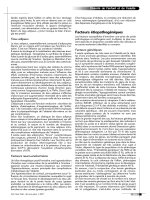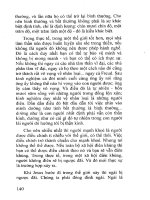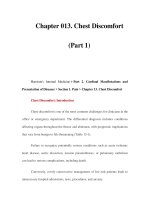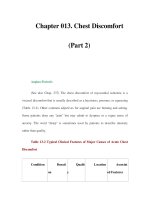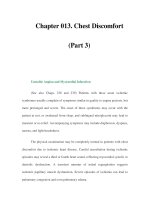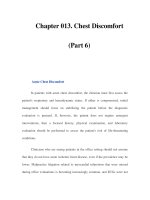Chapter 013. Chest Discomfort (Part 5) docx
Bạn đang xem bản rút gọn của tài liệu. Xem và tải ngay bản đầy đủ của tài liệu tại đây (11.92 KB, 5 trang )
Chapter 013. Chest Discomfort
(Part 5)
Approach to the Patient: Chest Discomfort
The evaluation of the patient with chest discomfort must accommodate two
goals—determining the diagnosis and assessing the safety of the immediate
management plan. The latter issue is often dominant when the patient has acute
chest discomfort, such as patients seen in the emergency department. In such
settings, the clinician must focus first on identifying patients who require
aggressive interventions to diagnose or manage potentially life-threatening
conditions, including acute ischemic heart disease, acute aortic dissection,
pulmonary embolism, and tension pneumothorax. If such conditions are unlikely,
the clinician must address questions such as the safety of discharge to home,
admission to a non-coronary care unit facility, or immediate exercise testing.
Table 13-3 displays a sequence of questions that can be used in the evaluation of
the patient with chest discomfort, with the diagnostic entities that are most
important for consideration at each stage of the evaluation.
Table 13-3 Considerations in the Assessment of the Patient with Chest
Discomfort
1. Could the chest discomfort be due to an acute, potentially life-
threatening condition that warrants immediate hospitaliza
tion and aggressive
evaluation?
Acute ischemic heart disease Pulmonary embolism
Aortic dissection Spontaneous pneumothorax
2. If not, could the discomfort be due to a chronic condition likely to lead to
serious complications?
Stable angina
Aortic stenosis
Pulmonary hypertension
3. If not, could the discomfort be due to an acute condition that warrants
specific treatment?
Pericarditis
Pneumonia/pleuritis
Herpes zoster
4. If not, could the discomfo
rt be due to another treatable chronic
condition?
Esophageal reflux Cervical disk disease
Esophageal spasm
Arthritis of the shoulder or
spine
Peptic ulcer disease Costochondritis
Gallbladder disease
Other musculoskeletal
disorders
Other gastrointestinal conditions Anxiety state
